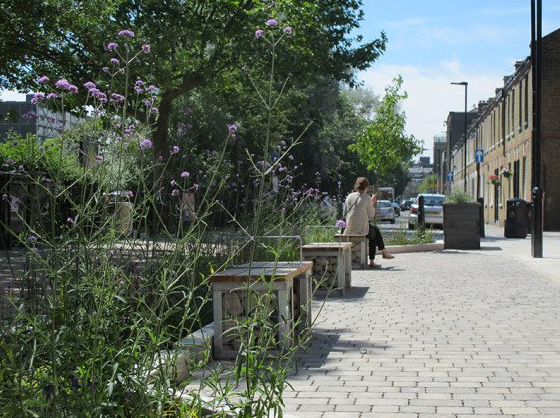By James Carson
Last summer, a report for the Heritage Lottery Fund offered mixed news on the state of public parks in the UK. While increasing numbers of parks were reported to be in good condition, and visitor numbers and levels of satisfaction also rising, the study found evidence that public parks are now facing many significant challenges:
“As public spending has fallen parks have faced large cuts in their funding and staffing over the last three years, and these cuts are expected to continue over much of the rest of this decade.”
It’s heartening, then, to see that a project aiming to create new green spaces is now bearing fruit. This month, the Mayor of London announced the successful delivery of 100 pocket parks across the capital.
Pocket parks are small areas of public space with trees and greenery, places to sit and relax and spaces for people to socialise. They also contribute to making the city friendlier, greener and more resilient, and have been instrumental in contributing to public health in low income areas.
Pocket parks in London
London’s pocket parks scheme, taking in 26 boroughs, has benefited from £2m in funding from the Greater London Authority. The programme has supported local communities and volunteers in rejuvenating and transforming small patches of uncultivated and overlooked land into lush green spaces for everyone to use and enjoy. Some examples give a flavour of the varied and inventive nature of pocket parks:
- The edible bus stop
London’s first pocket park provided a blueprint for making small-scale green infrastructure interventions a reality across the capital. The park was created beside the bus stop on Landor Road, Stockwell, by a team of ‘guerrilla gardeners’ working with the local community. This once forgotten space has now been transformed into a thriving garden and neighbourhood hub.
- Derbyshire Street Pocket Park, Bethnal Green
This project transformed a dead-end road that attracted anti-social behaviour and fly-tipping into a safe and vibrant community space, incorporating a rain garden, seating areas, a cycle lane and permeable paving.
- Canning Town Caravanserai
The current plot of this project, near Canning Town station, is due to be reclaimed by a developer, leaving the community without a permanent space. In response the Pocket Parks team has embraced the idea of moveable growing spaces. The resulting ‘mobile parks’ will provide areas that have limited park access with gardening space and activities.
- Hackney pocket park
Residents of Hackney’s Trelawney estate generated many of the ideas that has resulted in this new pocket park, including a space for local people to meet and improved wildlife habitats. The planting scheme acknowledges the site as the location of what was in the 19th century the largest hothouse in the world, with an unrivalled collection of palms, orchids and ferns, which helped influence planting in the rest of the UK.
Pocket parks beyond London
The pocket parks approach is not confined to the UK capital. There are good examples elsewhere in the country and overseas.
In Newcastle-upon-Tyne, the city council and business development company NE1 have been working together on pocket parks. One original idea is Quayside Seaside. Complete with deck chairs, palm trees and buckets and spades, creates a space where the visitors can unwind, build sandcastles and enjoy a free game of volleyball. Originally opened in the summer of 2011, the installation has proved to be so popular that it has become an annual fixture in Newcastle’s calendar of events.
Further afield, pocket parks are providing residents and visitors with oases inside the concrete jungle.
Complementing, not competing
The growth of pocket parks shouldn’t obscure the need to look after our larger public parks. As the Heritage Lottery Fund report observed, “they are deeply rooted in the physical fabric, spirit and identity of thousands of places across the UK”. Pocket parks should be seen as complementing rather than competing with these bigger green spaces, in helping to make the pressures of urban life a little less stressful for us all.
Enjoy this article? Read our recent blog on Designing new wildlife-friendly housing developments.
Follow us on Twitter to see what developments in public and social policy are interesting our research team.
We’ve made some of our member briefings freely available. View a selection of our environment publications on our website.
Share
Related Posts
Supporting residents on the decarbonisation journey: leveraging data for effective retrofit projects
As the drive towards decarbonisation intensifies, the social housing sector’s ability to collect, store and manage vast amounts of data becomes increasingly critical. With a shared goal of creating warmer, carbon-free homes, housing associations’ strategic use of data is essential ....
The recent spikes in energy costs have thrown into sharp focus the challenge of heating our homes. Domestic heating is important, not just for our comfort and wellbeing, but to reduce humidity and prevent condensation. But because traditional heating systems ....
Tackling geographical inequalities is critical for ensuring that all parts of the country have the potential to prosper. When the UK was a member of the European Union, it was entitled to a share of funding from the EU’s structural ....


